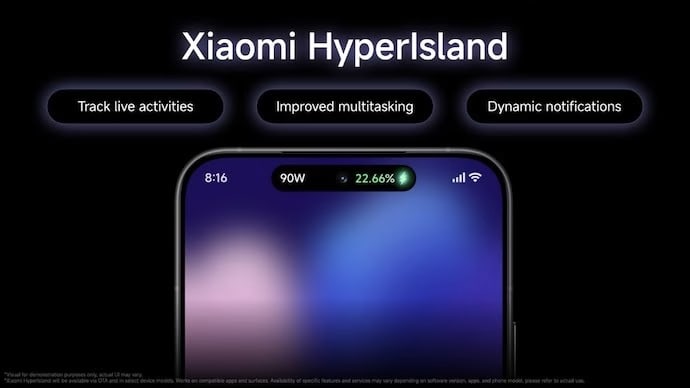New Android devices spark debate over design inspiration and imitation

Xiaomi's latest hardware releases are making waves, not just for their compelling specifications but also for their striking visual resemblances to Apple's popular products. The company has introduced 'Hyper Island,' a new interactive notification system, and the 'Pad Mini,' a compact tablet, both of which bear unmistakable design cues from Cupertino's offerings. This move continues a long-standing trend for Xiaomi, where innovation often walks hand-in-hand with clear inspiration from Apple's design language.
The unveiling, which occurred around September 24-25, 2025, has already ignited discussions across tech forums and social media. While Xiaomi consistently delivers strong Android hardware, the visual parallels are hard to ignore, prompting questions about where the line between inspiration and imitation truly lies.
One of the most talked-about features is 'Hyper Island,' Xiaomi's answer to Apple's Dynamic Island. Introduced by Apple on the iPhone 14 Pro, the Dynamic Island transformed the static camera cutout into a fluid, interactive hub for alerts, ongoing activities, and system information. Xiaomi's Hyper Island, integrated into its HyperOS 3 software (built on Android 16), aims to achieve a similar seamless integration of notifications and live activities.
Launched alongside the Xiaomi 15T series, Hyper Island is designed to dynamically expand and contract around the front camera housing, displaying everything from incoming calls and timers to music playback controls and app previews. Xiaomi emphasizes its ability to "seamlessly integrate notifications into your daily flow," promising smooth animations and customization options. Early demonstrations suggest it can handle multitasking previews, similar to Apple's Live Activities feature, for things like sports scores or ride-sharing updates.
While the functionality appears robust, the visual similarity to Apple's Dynamic Island is striking. This has led to widespread commentary online, with many users humorously noting the direct comparison. Experts suggest that while Hyper Island offers a polished experience, its true performance might depend on the underlying hardware, potentially facing challenges on less powerful devices compared to Apple's tightly integrated hardware and software ecosystem. Nevertheless, for Android enthusiasts, it represents a significant enhancement to notification management and system interaction.
Alongside the software innovation, Xiaomi has also launched the 'Pad Mini,' a device that clearly targets the compact tablet market dominated by Apple's iPad Mini. This 8.8-inch tablet boasts a sleek, minimalist design with slim bezels and a premium metal unibody construction, echoing the aesthetic that has made Apple's smaller tablets so popular. Measuring a mere 6.46mm thick and weighing just 326g, it's impressively light, even lighter than its closest Apple counterpart.
The Pad Mini is packed with impressive hardware. It features an 8.8-inch LCD display with a sharp 3K resolution (3008 x 1880 pixels) and a buttery-smooth 165Hz refresh rate, offering a superior visual experience for scrolling and gaming. Under the hood, it's powered by the MediaTek Dimensity 9400+ chipset, paired with up to 12GB of LPDDR5X RAM and 512GB of UFS 4.1 storage, promising flagship-level performance.
Xiaomi hasn't skimped on battery life either, equipping the Pad Mini with a substantial 7,500mAh battery that supports 67W fast charging. The inclusion of dual USB-C ports is a thoughtful touch, adding to the device's versatility. For audio, it features quad speakers tuned for spatial audio, and it also supports stylus input, positioning it as a capable device for both productivity and entertainment.
The design language is where the most direct comparisons arise. The flat edges, aluminum frame, and even the muted color options strongly resemble the iPad Mini. However, Xiaomi leverages the inherent flexibility of Android, offering features like native multitasking windows and deeper integration with Google services. This blend of familiar aesthetics with Android's open ecosystem presents a compelling alternative for consumers.
The introduction of Hyper Island and the Pad Mini places Xiaomi squarely in competition with Apple's established product lines. The Pad Mini, in particular, is priced very aggressively. Reports suggest a starting price in China around ¥1,999 (approximately $280 USD), significantly undercutting the iPad Mini's starting price. This value proposition is expected to resonate with budget-conscious consumers, students, and creators looking for a capable compact tablet without the premium price tag.
Community reactions have been a mix of admiration for Xiaomi's ability to deliver feature-rich hardware at competitive prices and criticism regarding the overt design similarities. While some celebrate the accessibility of premium features on Android, others express concerns about intellectual property and the lack of original design innovation.
From a market perspective, these launches align with Xiaomi's aggressive expansion strategy in 2025. The company has seen significant growth in tablet shipments, and the Pad Mini is poised to challenge Apple's dominance in the sub-10-inch segment. Whether these devices will be seen as genuine innovation or simply well-executed clones remains to be seen, but they are undoubtedly pushing the boundaries of what consumers can expect from the Android ecosystem.
Xiaomi's strategy of drawing heavily from established design trends isn't new. However, with 'Hyper Island' and the 'Pad Mini,' the company is not only replicating form but also function. This raises a perennial question in the tech industry: where does inspiration end and imitation begin?